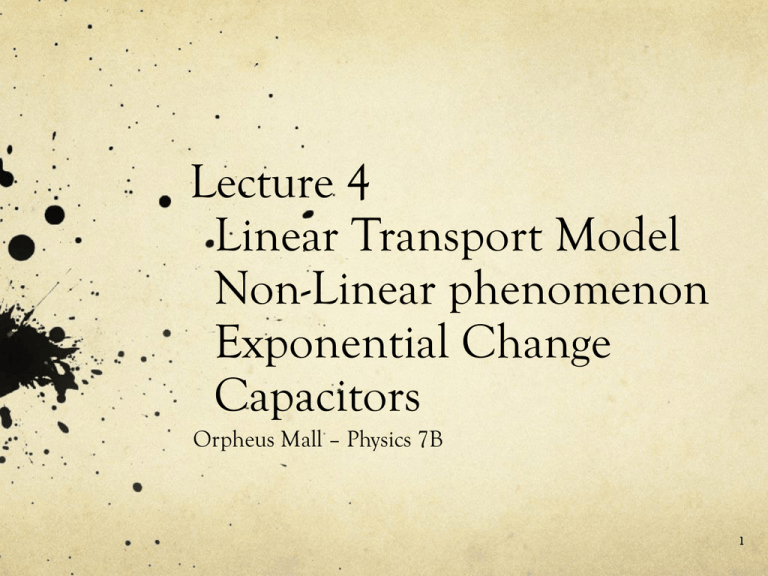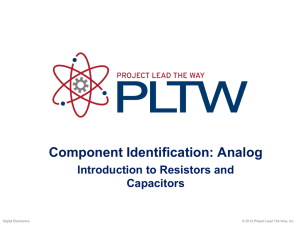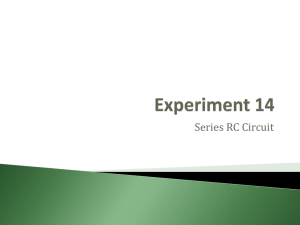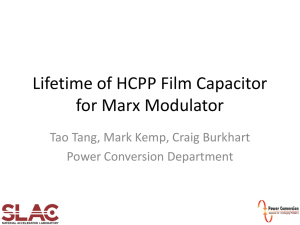Lecture4_oim - Nuclear Physics Group
advertisement

Lecture 4 Linear Transport Model Non-Linear phenomenon Exponential Change Capacitors Orpheus Mall – Physics 7B 1 Linear Transport Model: Flux = j If V j fluids A t A Ie Q jelectric A t A Flux is the Amount of stuff (Fluid, Current, Thermal Energy, Particles, Fields – 7C) passing through a given area in a given amount of time. More simply, flux is the flow per unit area. Linear Transport Model: Fluids Q: What causes flow in fluids? Δ(head) Q: What resists/allows flow? Rf / kf What is the flux at this point? Q: What flows? Vol. of fluid: V/Δt = If Thus Flux should be a property of these values Relating all these we already have: KE KE P IR V V (total head) = - I f R f From here we can determine flux through any point of the pipe using: 1 L Rf kf A We get: j fluids k f jf If A (head) L However, that’s for a section of the pipe, we want the flux at any point in the pipe. Thus we take the limit as ΔL becomes small: d(head) j fluids k f dx This equation is simply Bernoulli's principle, but at a point rather than comparing two points! Linear Transport Model: Electricity Q: What causes flow in a wire? ΔV Q: What resists/allows flow? Re / ke Q: What flows? – Charge: Q/Δt = Ie Thus Flux should be a property of these values Relating all these we have: V = - I e Re From here we can determine flux through any point of the resistor using: 1 L Re ke A je We get: jelectric k e Ie A V L What is the flux at this point: However, that’s for a section of the pipe, we want the flux at any point in the pipe. Thus we take the limit as ΔL becomes small: dV jelectric k e dx This is simply ohm’s law, but at a point rather than comparing two points. Heat: Conduction Heat always flows from areas of high T to areas of low T High Temperature Low Temperature Conductors – Metals: High heat conduction Insulators – Wood, Ceramics: Low heat conduction Q Heat transferred via thermal motion of electrons or atoms (oscillations – Phy-7A) Typically materials that are good electric conductors are good heat conductors as well Some notable exceptions: Silver – has high electric conductivity but lower heat conductivity than diamond Diamond – great conductor of heat, but has low electric resistivity Heat: Convection Heat always flows from areas of high T to areas of low T Heat is carried through motion of the medium (fluid motion) itself. Thus viscosity has an effect on convection The earth’s liquid iron outer core is responsible for the earth’s magnetic field that protects us from solar and cosmic radiation (Phy-7C) this convection is due to the heat transfer from the hot solid inner core to the cool lower mantle Heat transferred via fluidic motion http://www.nap.edu/books/12161/xhtml/images/p20015561g37001.jpg Heat: Radiation Everything warm emits Infrared Radiation Radiative heat needs no medium for transfer – can easily travel through space, i.e. heat from the sun. Is part of the Electromagnetic spectrum: Infrared (IR) Heat transferred via infrared radiation Global warming is the reflection of IR radiation from atmospheric greenhouse gasses that otherwise would escape the earth. IR is used in many applications such as military FLIR imaging systems http://therawfeed.com/pix/thermal_imaging_camera.jpg http://energysavingclub.files.wordpress.com/2007/01/greenhouse_effect.gif Linear Transport Model: Heat Q: What causes flow in a rod? ΔT High Temperature Low Temperature Q: What resists/allows flow? Rt / kt Q: What flows? – Heat: Eth/Δt = It Thus Flux should be a property of these values Relating all these we have: T = - I t Rt From here we can determine flux through any point of the rod using: Q What is the flux at this point? However, that’s for a section of the pipe, we want the flux at any point in the pipe. Thus we take the limit as ΔL becomes small: 1 L Rt kt A jt We get: jthermal k t It A V L jthermal dT k t dx This is simply ohm’s law, but at a point rather than comparing two points. http://www.youtube.com/watch?v=H7QsDs8ZRMI Linear Transport Model: Diffusion Q: What causes flow in a wire? Δc High conc. of Br2 Low conc. of Br2 Q: What resists/allows flow? Rd / D Q: What flows? Particles: #part/Δt = Id Thus Flux should be a property of these values Relating all these we have: c = - I d Rd From here we can determine flux through any point of the tube using: 1 L Rd D A jd Id A We get: jdiffusion D c L What is the flux of particles at this point? However, that’s for a section of the tube, we want the flux at any point in the tube. Thus we take the limit as ΔL becomes small: dc jdiffusion D dx This is known as Fick’s law where D is the diffusion constant. http://www.youtube.com/watch?v=H7QsDs8ZRMI Q: Why is it called the Linear Transport Model? The generalized Linear Transport Model equation for flux due to a potential difference phi is: d j k dx ϕ ϕ0 −j/k = slope Where ϕ may stand for head, voltage, temperature, concentration, etc. What is ϕ as a function of x? dy c dx y c dx y cx a d j dx k j dx k j x o k x Q: What assumptions did we make in order to make the flow linear and the flow rate constant over time? Infinite Source: Source doesn’t run out, so potential doesn’t change with time, so far we’ve assumed a steady-state. No dependence of flow on time. Ideal flow (Laminar vs. Turbulent), negligible viscosity Resistance is not dependent on the potential Non-Linear Phenomenon – Non Ohmic Resistors vdrift - - -- - - - - - - - - - Vapplied Ohmic resistors - Ohm’s Law: V IR For a realistic Resistor thermal motion is dependent upon the current. Current heats up resistor > higher thermal motion > lesser increase in current per increase in voltage. Imeasured Vapplied Non-ohmic resistors Semiconductors Example: Computer Overheating Imeasured Non-Linear Phenomenon – Dependence on source Recall Toricelli's result Note, for a realistic tank, the vB depends on the height of the fluid in the tank. Thus the flow rate changes with time! More specifically we can say that the current depends upon the volume of fluid in the tank. Note V is volume vA 0 vB ? 1 (v B2 v A2 ) g(y B y A ) 0 2 v B 2gh CurrentVol I V dV aV dt not potential and the negative sign is for decrease in volume with time. What function is it’s own derivative? y e at dy ae at ay dt Exponential Change: Population Growth The rate of increase of a population is proportional to the population. dp p dt p p0 e kt p p0 e Population p (1) 2p0 t ep0 (2) Where p0 is the population at time t = 0 Note: the time it takes for the population to double is known as doubling time, shown as t2 on the plot Note: sometimes you’ll see equation 2 with the Greek letter tau τ known as the time constant. τis the amount of time it takes for the population to increase by a factor of e = 2.7183 p0 Note that there is an asymptote along the x axis t2 τ It’s a good idea to know these! Time t Exponential Change: Nuclear Decay The rate of decay of a Radioactive isotope is proportional to the amount of material remaining dN N dt N N 0 e kt N N 0e Amount N N0 (1) t (2) Note: the time it takes for the material to be reduced by ½ is called the half life, denoted by t½ N0/2 Note that there is an asymptote along the x axis N0/e t1/2 τ Note: sometimes you’ll see equation 2 with the Greek letter tau τ known as the time constant. τis the amount of time it takes for the material to decrease by a factor of e = 2.7183 It’s a good idea to know these! Time t Exponential Change: Newton’s Law of Cooling The rate of cooling of a warm beverage at room temperature is proportional to the temperature difference between the beverage and the room. d(Trm Tbev ) (Trm Tbev ) dt T T0 e kt (1) T T0 e ΔT0 ΔT0/2 Note that there is an asymptote at Trm ΔT0/e t Temperature T (2) Note: the time it takes for the beverage to be cooled by ½ is called the half life, denoted by t½ Note: sometimes you’ll see equation 2 with the Greek letter tau τ known as the time constant. τis the amount of time it takes for the temperature difference to decrease by a factor of e = 2.7183 Trm t1/2 τ Time t A Q: What happens when we plug these plates into opposite terminals of a battery? Charge starts to build up on the opposite plates. Thus the capacitance (capacity) of a capacitor is equal to the charge accumulated per voltage applied. Q CV +++++ +++++ -Q | | | | | distance d by a ‘dielectric’ insulator in the middle. | | | | | Exponential Change in Circuits: Capacitors A parallel plate capacitor consists of two C metallic plates, with area A, separated a +Q d - ε + V IR V Q C R C F, Farads I A V V Recall: Ohm’s Law C 0 [F], Farads The build up of charge allows a capacitor d to behave like a battery a charged Q: In which direction would capacitor like to push the current? As Vm 1 for air or vaccum 0 8.85 1012 Note that this is not the same ε as the battery I 1 L R k A Recall: for a resistor R was also dependent upon geometry Exponential Change in Circuits: Capacitors Circuit Diagrams: Capacitors Circuit Diagrams: Resistors A C 0 d 1 L R k A Capacitors in parallel (~2xA) Resistors in Series (~2xL) C parallel C1 C2 ... Rseries R1 R2 ... Capacitors in series (~2xd) Resistors in parallel (~2xA) 1 Cseries 1 1 ... C1 C2 1 Rparallel 1 1 ... R1 R2 Exponential Change in Circuits: Capacitors - Charging A Capacitor is a bit like a rechargeable battery once the switch is closed current rushes to charge the capacitor. Q: As the Capacitor charges up, what direction does it try to push the current? Q: When will the charging stop? Q: Initially what is the voltage in the capacitor? What is the voltage in the resistor? What is the current in the circuit? Q: At the end, what is the voltage in the capacitor? What is the current in the circuit? What is the voltage in the resistor? VR=IR Voltage VC (V) ε Current I (A) ε/R I charging R e t RC , RCt ime const Time t (s) Q=CVC ε=20V t VC :charging 1 e RC , RCt ime const Time t (s) Exponential Change in Circuits: Capacitors - Discharging Now we use the charge stored up in the battery to light a bulb VB=IRB Q: As the Capacitor discharges, what is the direction of the current? What happens after some time? Q: Initially what is the voltage in the capacitor V0? What is the voltage in the bulb? What is the current in the circuit? Q=CVC Q: At the end, what is the voltage in the capacitor? What is the current in the circuit? What is the voltage of the resistor? Voltage VC (V) V0 Current I (A) V0/RB ε=20V t I discharging V 0 eR C, RB B RB Ct ime const Time t (s) VC :discharging V0 e t RC , RCtime const Time t (s) Exponential Change in Circuits: Capacitors Charging and Discharging a capacitor: Summary Charging: Initial ( I = Max , Q = 0 ) Final ( I = 0 , Q = Max ) ε 20V 20V C 0V (V=Q/C) 20V (V=Q/C) R 20V (V=IR) 0V (V=IR) Discharging: Initial ( I = Max , Q = Max ) Final ( I = 0 , Q = 0 ) C 20V (V=Q/C) 0V (V=Q/C) RB 20V (V=IR) 0V (V=IR) Capacitors: Energy Stored in a capacitor Because resistors dissipate power, we wrote a an equation for the power dissipated in a Resistor: P IV, using V IR : 2 V P I 2 R or P R Note: Since I is same for resistors in series, identical resistors in series will have the same power loss. Since V is the same for resistors in parallel, identical resistors in parallel will have the same power loss Because capacitors are used to store charge and energy, we concentrate on the energy stored in a capacitor. We imagine the first and the last electrons to make the journey to the capacitor. What are their ΔPE’s? ΔPEfirst=qΔV ,ΔV=20 ΔPElast =qΔV , ΔV=0 Thus on average for the whole charge: 1 PE QV , using Q = CV 2 1 PE CV 2 2 VR=IR Q=CVC ε=20V


![Sample_hold[1]](http://s2.studylib.net/store/data/005360237_1-66a09447be9ffd6ace4f3f67c2fef5c7-300x300.png)





